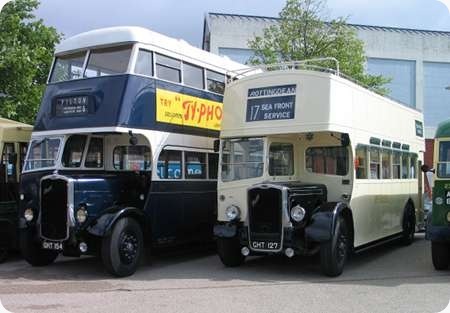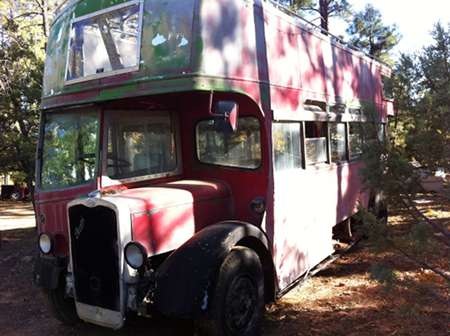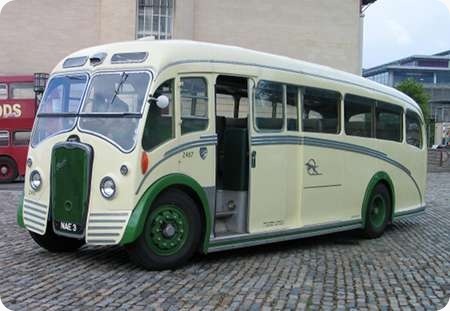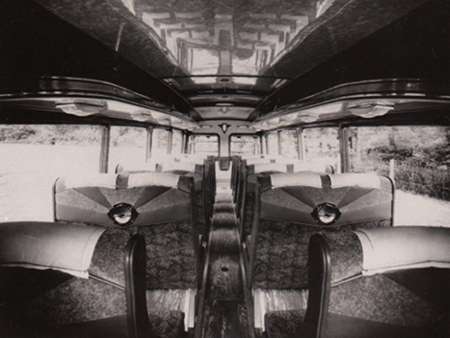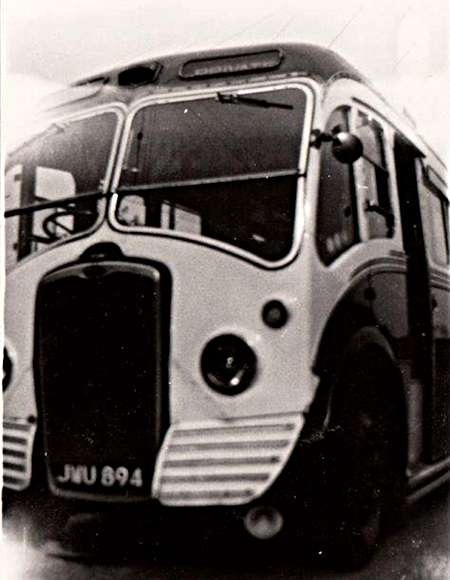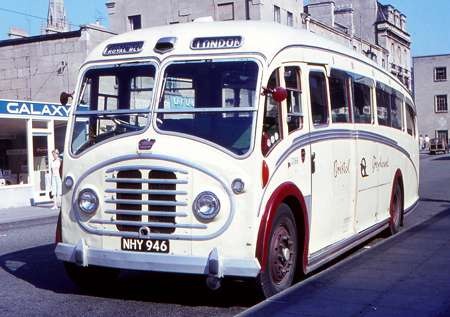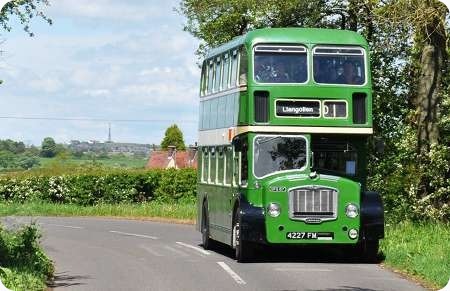
Crosville Motor Services
1964
Bristol Lodekka FS6G
ECW H33/27RD
Here is a Bristol Lodekka FS6G with rear entrance ECW body and dates from 1964. Crosville bought both long and short F series Lodekkas. DFG157 is one of the short ones. It was withdrawn by Crosville in 1977 and is now preserved
Photographed 8/5/2011 whilst in service at The Wedgwood Potteries rally – Take me home country roads.
Photograph and Copy contributed by Ken Jones
21/05/13 – 15:47
I always thought the FS was a more subtle bus than the FLF with just the right amount of side profile curvature, I can never decide whether I prefer this destination indicator layout or the T type as used by West Yorkshire. The bus is a true post war classic especially when fitted with a Bristol engine, although others may differ.
Chris Hough
22/05/13 – 07:30
The Bristol BVW engine and the earlier AVW, like the Daimler CD6, were introduced in part to relax the constraints placed upon chassis production volumes by the limited supply of Gardner power plants. The AVW was a straightforward dry liner engine, and proved fairly trouble free, but the wet liner BVW, introduced in 1957, did give problems in service, and went through a series of modifications. In the 1970s, when the Stokes led Leyland empire dominated the industry, BVW production was halted and spares became very difficult to obtain. Several Tilling group companies re-engined some of their BVW powered Lodekkas with Gardner units in consequence.
Roger Cox
22/05/13 – 08:55
And it’s the "right" shade of green for a Bristol/ECW combination, not that dreadful NBC attempt . . .
Pete Davies
22/05/13 – 09:39
Roger, is of course, right in every respect. What he didn’t say was that there were continuing capacity problems at Gardner’s and British Leyland then offered the O.600 as an alternative to the withdrawn BVW option – which was taken up by Hants & Dorset and Wilts & Dorset.
David Oldfield
22/05/13 – 11:11
And once again Ken, a really superb photo of a preserved bus caught in a timeless landscape looking just as it would have in its heyday, rather than parked in a line up on some car park, all covered in rally stickers, and surrounded by stalls and people in high-vis. Keep up the good work !
I agree with you about the FS, it was a superbly proportioned design. Just ‘right’. Though the Gardner engined Lodekka almost by definition had to be the most reliable and efficient version, speaking purely from an enthusiast’s aesthetic point of view, they just had to have Bristol engines. Along with most AEC’s, the Bristol-engined Bristol was one of my favourite bus sounds ever.
John Stringer
22/05/13 – 17:51
You and me both, John – AEC & Bristol engines. But there were problems with wet-liners with both makes…..
David Oldfield
23/05/13 – 07:58
The whine of a Regent V box always made me think we`re going back to the days of the TD1 !
Jim Hepburn
23/05/13 – 07:58
Ken, thank you for posting a photograph that is beyond superb. This photograph manages to capture the very essence of Crosville, a Bristol Lodekka and a rural scene. I could look at this photograph for hours and never get tired.
Kevin Hey
23/05/13 – 07:59
May I suggest that the date was Sunday the 18th rather than the 8th? I was at the Rally and travelled on this Lodekka. It brought back fond memories of my daily travels from Gresford to grammar school in Wrexham on umpteen Crosville Ks and Lodekkas on the D1 service heading ultimately for Llangollen.
When I filmed the bus at the Rally mid-afternoon, it was displaying ‘Private’ and ‘D45’. Presumably, the destination had been changed to avoid misleading any intending passengers, though an ex-Devon General Atlantean proudly displayed ‘Dawlish’ all day.
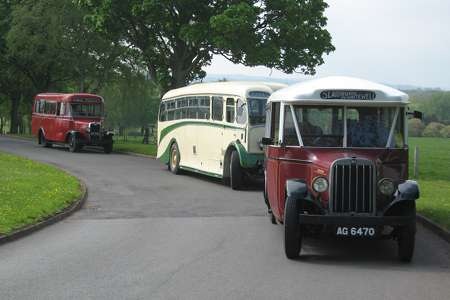
This was the first time I’d attended the Potteries Rally and was amazed to see the line-up of elderly vehicles put on show by the Emerton Brothers as ‘Bounty Country Buses’. Seeing a Dennis Ace and two Crossley coaches, among other gems, was a truly heart-warming experience.
Berwyn Prys Jones
23/05/13 – 07:59
A lovely shot Ken, and good to see the bus in Tilling green as Pete says. Also good to see the Lodekka grille and surround as they should be, and not painted green as sadly Crosville appeared to do with so many of their Lodekkas on repaint. (Northern General treated their acquired examples similarly if memory serves correctly). Even if the buses were sprayed, rather than hand-painted, surely there was no excuse for such corner-cutting shodiness. Things didn’t improve with the advent of NBC’s corporate livery, as Crosville along with many other NBC subsidiaries, then painted the mudguards the same colour as the main bodywork as well. Some operators (West Yorkshire, Southern Vectis and Red & White spring to mind) at least attempted to keep some standards under NBC’s somewhat cheapened paint application, by retaining black mudguards front and rear. This did seem to lift the livery on half-cab vehicles, but sadly most NBC subsidiaries did not avail themselves of this.
While the BVW engine did have some problems with the wet liners, the bottom end was just about bomb-proof, and West Yorkshire’s examples achieved some amazing mileages between overhauls. Head gasket failures were not uncommon at one time, but much of the problem was felt to be due to the infamous CBC ‘heating’ system and its airlock-inducing pipework, rather than the engine itself. It is surely no coincidence that as WY steadily converted many of its later CBC Lodekka ‘steamers’ to conventional radiator and heater layout, the boiling and head gasket problems seemed to decrease.
As for Lodekka engine sounds – the induction roar of the AVW, the somewhat more powerful sound of the BVW, the ‘staccato’ bark of the 5-pot Gardner, the purposeful growl of the 6-cylinder Gardner (LW and LX) – I love ’em all!
Brendan Smith
23/05/13 – 10:12
…..but the music of the "pre-war" whine is part of the attraction of the Regent V. [Posted by a professional musician!]
David Oldfield
23/05/13 – 10:13
I’m glad this picture is generating such positive responses especially as I took it on the move from another vehicle. It’s very pleasing when someone says they could look at it all day. You start to see buildings etc you hadn’t previously noted.
I don’t generally argue about comments as I know next to nothing about buses. I have to confirm the date as 8th May though – it’s on the picture generated by the camera and I attach a calendar for May 2011.
I’ve now been to four of these Potteries Rallies and two at Hanley all organised by POPS. I’ve just donated all the pictures I’ve taken from all these events to their group
Ken Jones
The 8th of May 2011 was a Sunday the 18th was a Wednesday.
23/05/13 – 16:12
David O, I respect your professional musical knowledge, but with regard to the Regent V, I confess that I always felt cheated. My first experience of the type was with the Nottingham variety that appeared about 1956, and although the sound was quite nice, it always seemed to me a cheap and jazzed up imitation of the real pre- and post-war sliding mesh gearbox Regent sound. I am afraid that familiarity bred contempt for the homely soothing pre-selector Regent, that seemed almost universal in NCT at that time.
Stephen Ford
24/05/13 – 15:14
David, I must point out I had high regard for TD1s. Our local company at the time, Chieftain Buses of Hamilton had several second-hand examples in my schooldays.
One of them, which would have qualified for the Ugly Bus page, with a UF registration, so presumably came from Brighton, had the smoothest ride of any bus I have ever ridden on – including modern coaches.
Jim Hepburn
26/05/13 – 07:47
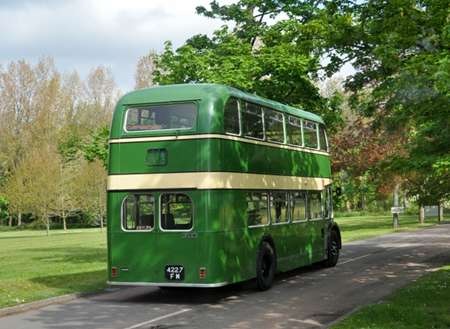
This year I had the opportunity to photograph the vehicle to the rear. It’s heading for the Potteries Rally and I took this shot from JFJ 873.
Ken Jones
27/05/13 – 06:55
On the subject of bus music, I am suffering from Regent V deficiency at the moment. I expect I’ve got a recording of one somewhere, but I don’t think my wife would have appreciated that with her lunch, so I had to make do with Sibelius 5 (the last movement has a certain similarity!).
I must confess, though, that I prefer the sound of a Gardner engine, and it is a source of frustration that, during the brief period when AEC offered them, there never were any D3RV6Gs to go with Glasgow’s D2RV6Gs and the D2RA6Gs at Rochdale and Aberdeen. Not only has this deprived me of what would have been an interesting array of sound effects, but it also deprived the world of a double decker with a Gardner engine and a synchromesh gearbox that worked properly – something which I would have thought highly desirable.
Peter Williamson
27/05/13 – 09:01
On the subject of musical parallels with the bus world, I suppose the nearest equivalent to a trolleybus would be John Cage’s ‘4 mins 33 secs’. I yearn for the day when Radio Three’s ‘Building a Library’ undertakes a comparative evaluation of this piece.
Roger Cox
28/05/13 – 07:38
I recall going to a concert in Bristol many years ago when this piece was played. It was a very ragged performance, I assume because the orchestra was under-rehearsed!
Chris Hebbron
28/05/13 – 11:01
You’ve just given me an idea, Roger. I will do an arrangement of the Cage for organ and include it in my next recital.
The music of the pre-selector is a distinctly different, and none the worse, experience from the syncro "whine" – both are equally valid. I would point out the gear-box rather than the engine is the most critical instrument (just as the building is rather the THE instrument in the Cage).
Ken. You’ve just proved how attractive the back end of a bus can be.
David Oldfield
28/05/13 – 17:00
That reminds me of a Sketch from the radio comedy programme "Take It From Here" many years ago about Cleopatra:-
….And truly men call her Desire.
Because she is so beautiful? No. from the back she looks like a street-car!
Jim Hepburn
04/06/13 – 06:57
A belated apology to Ken Jones! I was talking about the 2013 rally date rather than 2011 and should have read Ken’s text more carefully. The Lodekka attended both rallies.
The photo I sent in of the three buses owned by the Emerton Brothers was taken at this year’s rally.
Berwyn Prys Jones
05/07/13 – 06:07
For those of you who like timeless views of Crosville vehicles in preservtion may I suggest you pay my flickr pages a visit? You may have to soft-focus on a few modern vehicles and signs on some of them but there should be enough "uncontaminated" views there to make it worth your while.
Five photo excursions rounded up here:
LH visiting Wrexham-Ruthin-Denbigh-Llanrwst
www.flickr.com/photos/crisparmour/sets/1
Busway RE revisits old haunts
www.flickr.com/photos/crisparmour/sets/2
Dual door RE in Gwynedd
www.flickr.com/photos/crisparmour/sets/3
D94 revisited with DP RE
www.flickr.com/photos/crisparmour/sets/4
LH in Snowdonia
www.flickr.com/photos/crisparmour/sets/5
crisparmour
19/07/13 – 08:52
Growing up in 1960s Bournemouth the sight and sound of a Hants&Dorset Lodekka ascending Commercial Road has stayed with me over the years. The FS6G type (as pictured here) seemed a very business-like no-nonsense bus, perfect for the country roads which made up a lot of their routes. I did many trips to Fordingbridge on those as a passenger, and appreciated their rugged if somewhat spartan accommodation. Their appearance was perfectly balanced and probably the finest of all the Bristol buses IMHO.
In comparison, the local BCT buses seemed rather lady-like!
Grahame Arnold
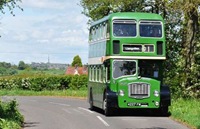 Vehicle reminder shot for this posting
Vehicle reminder shot for this posting
03/09/14 – 07:17
Seeing the photo of DFG 157 which was based at Wrexham brought back old memories of the 1960’s where I was employed as a driver. I remember taking her over on the D1 stand on her first day in service going to Llangollen then back through Wrexham bus station to Chester and return on the D1 route. What a difference to the DLG and DLB’s previously on the D1 service.
My favourite bus in the Wrexham depot was SLG 144. This single decker had fantastic pulling power and when I was on a route with hills and it was parked up at the bus station I used to ‘swop’ it over with the one I was due to take over. When the engine was ticking over it had a strong sounding diesel ‘knock’. I also remember I got the knack of going through the gear box from 2nd to 5th without the use of the clutch using the speedometer and engine revs. Great days and in the years I was at Wrexham I never had one mechanical breakdown. SLA 42 had the side taken out of her when I was at a bus stop on Derby road when a council snow plough slid down the hill and rolled the aluminium side of it like a tin opener. Myself and conductor picked it up and put it in the bus and took it with us on a colliery run! Some years later on a school run from Mild to Treuddyn via Cymau SLG 138 went on fire under the bonnet. I emptied the fire extinguisher into the engine bay through a large hole in the side about six inches diameter and it went out. The engine restarted and we carried on to Treuddyn. Running back light to Wrexham it went on fire again and luckily a service bus came along and we had his extinguisher to put it out. We later discovered some rags had been left in the engine bay and had fallen onto the exhaust manifold. Next day I had old SLG 138 again on Pentre/Moss/Tanyfron/Brymbo. Tough old buses Crosville had.
Brian Wright
03/09/14 – 18:00
Thx for re-living your experiences with us, Brian, a part of history always worth recording for others to enjoy. Snow plough, eh? Bet you never dreamt that that would happen to you!
Chris Hebbron
